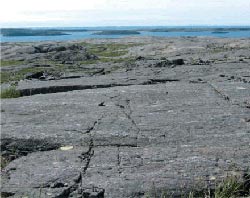We have lots of techniques for getting the rough age of the Earth, and we have a handful of techniques for getting a detailed age. The latter fall under radioactive dating methods, and they are very accurate; we can measure with incredible precision the decay rates of some elements, and these form an almost literal ticking clock that can be read.
The Earth is 4.567 billion years old, plus/minus a small fraction of that. The thing is, finding intact rocks close to that age is hard. The Earth is active, with rocks getting subducted deep into the crust (and below), new rocks forming, erosion weathering them into dust, and so on.
 So it’s pretty amazing that in Quebec, rocks have been found that are about 4.3 billion years old. They were discovered in the Nuvvuagittuq greenstone belt of northern Quebec, and the age was determined looking at ratios of isotopes of the elements samarium and neodymium.
So it’s pretty amazing that in Quebec, rocks have been found that are about 4.3 billion years old. They were discovered in the Nuvvuagittuq greenstone belt of northern Quebec, and the age was determined looking at ratios of isotopes of the elements samarium and neodymium.
These rocks date back to the time that the Earth’s crust was separating from the mantle, and even predate the time of heavy bombardment, when the Earth was pummeled by asteroid and comet impacts. The rocks were formed well after the impact that formed the Moon however, which happened less than 100 million years after the Earth itself formed.
I’ll add that small grains of minerals have been found that date back 4.3 billion years as well, but this is the first time extant rocks have been discovered. Science magazine has the full story (subscription required).
 On a personal note, a few months ago I was giving a talk in Canada, and we visited the Ontario Science Centre. They had a timeline of the Earth laid out down a corridor, with rocks representing the various ages. That fellow on the left is a chunk of gneiss dated to be 4 billion years old, one of the oldest known rocks (I think it was the oldest known when it was found). It was sitting out there, so anyone could touch it. I am not mystical in any sense, but there was something very cool about touching the rock, actually contacting it physically. Monkey instincts, I guess, using our hands and fingers.
On a personal note, a few months ago I was giving a talk in Canada, and we visited the Ontario Science Centre. They had a timeline of the Earth laid out down a corridor, with rocks representing the various ages. That fellow on the left is a chunk of gneiss dated to be 4 billion years old, one of the oldest known rocks (I think it was the oldest known when it was found). It was sitting out there, so anyone could touch it. I am not mystical in any sense, but there was something very cool about touching the rock, actually contacting it physically. Monkey instincts, I guess, using our hands and fingers.
The funny thing is, you’d walk right past it if you saw it in the dirt. It would look like an ordinary, if rather pretty, chunk of stone. But our other good monkey instincts are curiosity, and the ability to examine things, figure out how they work, why they exist. Some scientists somewhere studied geology, others studied radioactivity, others investigated how the Earth’s surface formed. Together, these remote cousins (gneisses?) found all the clues we needed to put together the history of this rock, the Earth’s surface, and the Earth itself.
If you want to believe the Earth is 6000 years old, then you have that right. But you are one of the blind men feeling the tail of an elephant and claiming it’s a rope. You’re missing the big picture, and in this case, it’s a tapestry far richer, more satisfying, and more beautiful than you can know.
Tip o’ the gelogist’s hammer to Philippe Hamel and to Fark, which gave this story this marvelous headline: “6,000 year-old rocks found in Quebec.” Credit for the first picture:Credit: Jonathan O’Neil/McGill Univ. via Science magazine. Second picture taken by me.